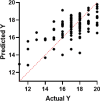Effectiveness of a self-management program for anticoagulated patients to improve their knowledge about treatment and time in therapeutic range
- PMID: 39495974
- PMCID: PMC11537636
- DOI: 10.1097/MD.0000000000040258
Effectiveness of a self-management program for anticoagulated patients to improve their knowledge about treatment and time in therapeutic range
Abstract
Oral anticoagulation self-control programs have demonstrated efficiency and cost-effectiveness over recent years. This study aimed to evaluate the effectiveness of a training intervention focused on patients with antivitamin K anticoagulants included in a self-care program. For this, we made a quasi-experimental study, pretest and post-test, using a validated questionnaire with 2 measures, before and after an educational intervention about oral anticoagulation focused on patients that will initiate the self-control program in consultation. To check the patient's adherence and coagulation level, we evaluated the Rosendaal time in therapeutic rank, both before and after the intervention. One hundred fifty patients were included since the start of the self-monitoring program in our center in 2016. The mean age was 49 years (standard deviation [SD] = 17.24). The distribution by gender was 76 women and 69 men (52.4%-47.6%). The mean score for the first test was 14.61 (SD = 3.26) and the mean score for the second test was 17.01 (SD = 2.14) (P <.001). We also measured Rosendaal time in therapeutic rank, a parameter that indicates stabilization in international normalized ratio determinations and quality of the anticoagulation management. Values before and after interventions were also statistically significant (67.46 vs 70.53, P <.001). Patients' knowledge improved after the training session, with statistical significance. Despite intentional sampling, the population was homogeneous. Scoring data dispersion in the second test was significantly lower than in the first one. Time on therapeutic rank values was better after the training. We intend to adapt its content to the rest of anticoagulated patients to enhance and improve their follow-up.
Copyright © 2024 the Author(s). Published by Wolters Kluwer Health, Inc.
Conflict of interest statement
The authors have no funding and conflicts of interest to disclose.
Figures




References
-
- National Institute for Health and Clinical Excellence (NICE). Anticoagulation therapy service commissioning guide. Implementing NICE guidance. London: NICE; 2010. https://data.parliament.uk/DepositedPapers/Files/DEP2012-1905/HL3907-Lib.... Accessed July 12, 2023.
-
- Gómez-Doblas JJ, Muñiz J, Alonso-Martín JJ, et al. . Prevalencia de fibrilación auricular en España. Resultados del estudio OFRECE. Rev Esp Cardiol. 2014;67:259–69. - PubMed
-
- Camm AJ, Kirchhof P, Lip GYH, et al. . Guidelines for the management of atrial fibrillation. The Task Force for the management of atrial fibrillation of the European Society of Cardiology (ESC). Eur Heart J. 2010;31:2369–429. - PubMed
-
- Llanos Méndez A. Efectividad de la automonitorización y autocontrol del tratamiento con anticoagulantes orales antagonistas de la vitamina K. Revisión sistemática. Informes de evaluación de tecnologías sanitarias AETSA. Sevilla- Agencia de Evaluación de Tecnologías Sanitarias de Andalucía. 2014.
MeSH terms
Substances
LinkOut - more resources
Full Text Sources
Medical

